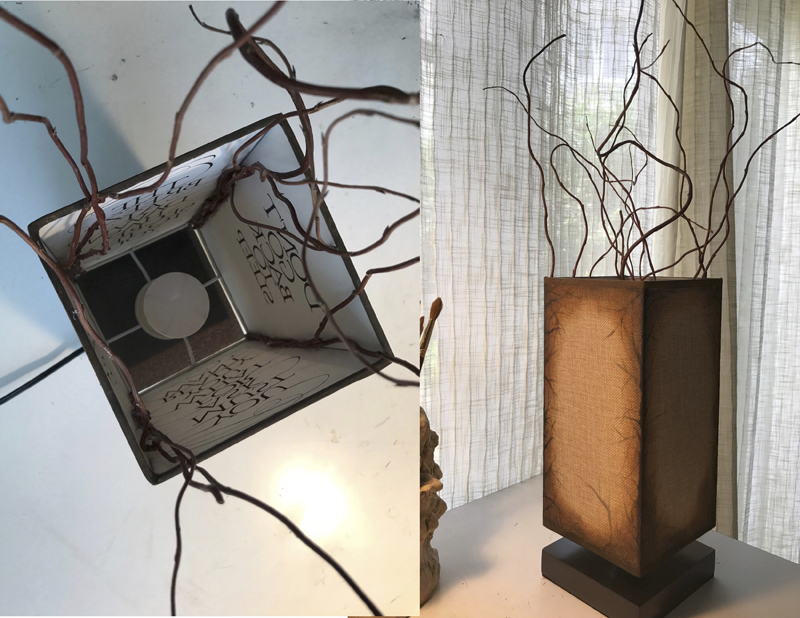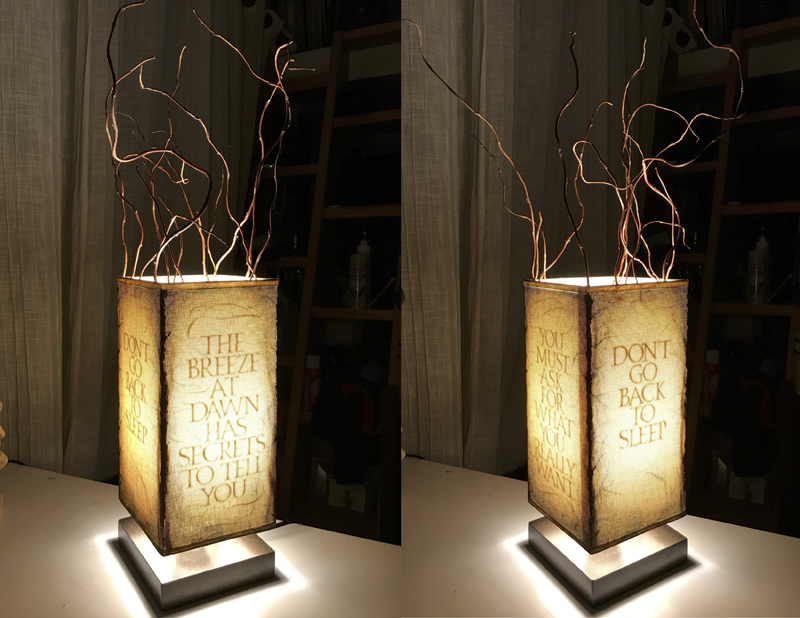“Don't Go Back To Sleep”
Every calligrapher prays
for the moment when the proverbial light comes on; that
moment when you can finally see the piece. For me, those
moments are illuminating, in every sense of the word.
So, when trying to find a way to capture the essence of
one of my favorite Rumi quotations, I decided I had to
do pressurized Roman caps on a lamp!
The first order of
business was to find the right lamp. It had to have a
shade of equal sides, at least 5" wide and a height of
at least 10" or more and a narrow, square, dark wooden
base. To my amazement, I found one online! I also went
to my local florist and bought some dried willow
branches with the idea of attaching them to the four
corners of the shade. (Don’t you love a good glue gun?!)
I thought this would be a way to draw the light out of
the lamp.
Now, how to write on the
fabric!? I quickly had to rule that out since the shade
was made out of linen. The obvious solution was to
attach the calligraphy on the inside liner of the shade.
Now came the really tricky part: In order to be able to
read the lettering on the outside, it had to be
written backwards on the
inside: the ultimate Reggie spacing exercise! So, I did
pressurized Roman caps (Mitchell nib) on 140 lb Arches
HP WC paper, using van dyke brown qouache, adding
flourishes (Hunt 101) to echo the movement of the
branches, backwards. Now that was fun! :/
The poem’s title and main message that is repeated three
times in the brief poem is repeated on two of the four
sides (and no, I didn’t just run it through the copier,
although I was tempted!), with the two other most
important lines of the poem lettered on the other sides. |
These lines are only visible when the lamp is switched
on. After the lettering and flourishing was all done
came the scariest part: attaching the paper to the
lampshade. I sprayed adhesive mounting glue onto the
back of the artwork and oh, so gently guided it down
into the lampshade, praying that it didn’t attach itself
to anything on the way down or worst yet, get attached
at a crooked angle. OCD calligrapher that I am, I
breathed a huge sigh of relief when that was done!
So, now to work on the outside.
I wanted the lamp to be equally attractive when in the
off position so I needed to create some drama. The
lampshade, which was a dull cream colored linen, needed
some depth of color and textural interest when
unilluminated, so I took my van dyke brown (acrylic
paint this time) and glazed color at the corners, along
the
bottom and top and painted “branches” coming out of the
sides, again, to mimic the willow branches bursting out
of the top.
The parallel message here for me is the way I can feel
when practicing Roman caps or italics or copperplate or
fill-in-the-blank hands. While still concentrating on
the task, it can sometimes feel very uninspired. (As a
professional musician, I do understand the importance of
practicing my scales but seriously, there are days,
right!?) But then, often after these long practice
sessions, I can pull out a delicious piece of Roma or
Arches or Fabriano or BFK Rives paper out of my file and
the “lamp” comes on. It seems as if the artwork has
simply been hiding out in the drawer all along. I just
had to bring enough energy to the work and then, in
turn, enough power was generated for me to be able to
see the piece. Don’t go back to sleep...the breeze at
dawn has secrets to tell you...you must ask for what you
really want...don’t go back to sleep...
This lamp now sits in my art studio overlooking my
calligraphy table, reminding me always about the work,
the process, and, hopefully, the illumination. |

